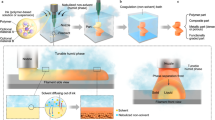Abstract
The successful inkjet printing of a cerium gadolinium oxide (Ce0.8Gd0.2O2) precursor solution on highly textured Ni-5%W is reported. A stable ink was synthesised from metal acetates and propionic acid with rheological properties suitable for inkjet printing and also the development of solid–liquid interface comparable with thin film formation by dip coating. Two different drop-on-demand print heads were used for deposition: a 16-nozzle piezoelectric cartridge and a single electromagnetic nozzle. Two different rastering patterns with different droplet sizes and spacing were compared. Thermogravimetry and X-ray diffractometry were used to study the thermal decomposition of the metal oxide precursors and to determine the shortest possible heat treatment of the deposited layers, potentially suitable for continuous large scale production. The results from X-ray diffraction show that the single phase Ce0.8Gd0.2O2 was obtained in all cases, but only piezoelectric inkjet printing with optimised drop overlapping produces a highly textured buffer layer. Optical micrographs and atomic force microscopy also indicate the good quality of deposited films after heat treatment.



















Similar content being viewed by others
References
Trovarelli A (1996) Catalytic properties of ceria and CeO2-containing materials. Catal Rev 38:439–520
Flytzani-Stephanopoulos M (2001) Nanostructured cerium oxide “ecocatalysts”. Mater Res Soc Bull 26:885–889
Corma A et al (2004) Hierarchically mesostructured doped CeO2 with potential for solar-cell use. Nat Mater 3:389–393
Steele BC (2000) Appraisal of Ce1−yGdyO2−y/2 electrolytes for IT-SOFC operation at 500 °C. Solid State Ionics 129:95–110
Murray EP, Tsai T, Barnett SA (1999) A direct-methane fuel cell with a ceria-based anode. Nature 400:649–651
Mogensen M, Sammes NM, Tompsett GA (2000) Physical, chemical and electrochemical properties of pure and doped ceria. Solid State Ionics 129:63–94
Norton DP et al (1996) Epitaxial YBa2Cu3O7 on biaxially textured nickel (001): an approach to superconducting tapes with high critical current density. Science 274:755–757
MacManus-Driscoll JL (1998) Recent developments in conductor processing of high irreversibility field superconductors. Annu Rev Mater Sci 28:421–462
Park C et al (1998) Bend strain tolerance of critical currents for YBa2Cu3O7 films deposited on rolled-textured (001) Ni. Appl Phys Lett 73:1904–1906
Cavallaro A et al (2006) Growth mechanism, microstructure, and surface modification of nanostructured CeO2 films by chemical solution deposition. Adv Funct Mater 16:1363–1372
Coll M et al (2008) Nanostructural control in solution-derived epitaxial Ce1−xGdxO2−y films. Nanotechnol 19:395–601
Norton DP (2004) Synthesis and properties of epitaxial electronic oxide thin-film materials. Mater Sci Eng R43:139–247
Sutoh Y et al (2004) Preparation of second buffer layers on IBAD tapes by PLD. Physica C 412–414:829–832
Obradors X et al (2004) Chemical solution deposition: a path towards low cost coated conductors. Supercond Sci Technol 17:1055–1064
Cavallaro A et al (2004) Chemical solution techniques for epitaxial growth of oxide buffer and YBa2Cu3O7 films. J Eur Ceram Soc 24:1831–1835
Bhuiyan MS et al (2003) MOD approach for the growth of epitaxial CeO2 buffer layers on biaxially textured Ni–W substrates for YBCO coated conductors. Supercond Sci Technol 16:1305–1309
Zhao Y et al (2007) Deposition of biaxially textured CeO2 thin films on single crystal and textured Ni5%W substrates using solution derived method. IEEE Trans Appl Supercond 17:3440–3442
Coll M et al (2009) All chemical YBa2Cu3O7 superconducting multilayers: critical role of CeO2 cap layer flatness. J Mater Res 24:1446–1454
Akin Y et al (2003) Textured CeO2 thin films on nickel tape by sol–gel process. IEEE Trans Appl Supercond 13:2563–2566
Celik E et al (1999) CeO2 buffer layers for YBCO: Growth and processing via sol–gel technique. IEEEE Trans Appl Supercond 9:2264–2267
Engel S et al (2005) An all chemical solution deposition approach for the growth of highly textured CeO2 cap layers on La2Zr2O7-buffered long lengths of biaxially textured Ni–W substrates for YBCO-coated conductors. Supercond Sci Technol 18:1385–1390
Akin Y et al (2003) Textured growth of multi-layered buffer layers on Ni tape by sol–gel process. IEEE Trans Appl Supercond 13:2673–2676
Cloet V et al (2006) Sol–gel ink-jet printing technique for synthesis of buffer layers of coated conductors. Adv Sci Technol 47:153–158
Arii T et al (2001) Thermal decomposition of cerium(III) acetate hydrate by a three-dimensional thermal analysis. Anal Sci 17:875–880
Arii T et al (2002) Thermal decomposition of cerium(III) acetate studied with samplecontrolled thermogravimetric–mass spectrometry (SCTG—MS). J Eur Ceram Soc 22:2283–2289
Knoth K et al (2005) La2Zr2O7 and Ce–Gd–O buffer layers for YBCO coated conductors using chemical solution deposition. Physica C 426–431:979–984
Chen S et al (2005) Biaxially textured CeO2 seed layers and thin films on Ni substrates by chemical solution deposition using inorganic cerium nitrate as a precursor. Physica C 419:7–12
Acknowledgments
The authors would like to thank Prof. Ian Hutchings (Inkjet Research Centre, Institute for Manufacturing, University of Cambridge) for access to the Dimatix Materials Printer and Dr. Mary Vickers (Department of Materials Science and Metallurgy, University of Cambridge) for help with pole figures. Mariusz Mosiadz would like to thank Dr. Nadia Stelmashenko (Department of Materials Science and Metallurgy, University of Cambridge) for help with atomic force microscopy. David Hardeman would like to thank Prof. Lindsay Greer (Department of Materials Science and Metallurgy, University of Cambridge) for the access to departmental facilities. This research was funded by the European Commission 6th Framework Programme (MRTN-CT-2006-035619), Marie Curie Actions, NESPA project (NanoEngineered Superconductors for Power Application) and partially supported by the European Commission 7th Framework Programme (EC-FP7-NMP-2007-SMALL-1) EFECTS (Efficient Environmental-Friendly Electro-ceramics Coating Technology and Synthesis).
Author information
Authors and Affiliations
Corresponding author
Rights and permissions
About this article
Cite this article
Mosiadz, M., Tomov, R.I., Hopkins, S.C. et al. Inkjet printing of Ce0.8Gd0.2O2 thin films on Ni-5%W flexible substrates. J Sol-Gel Sci Technol 54, 154–164 (2010). https://doi.org/10.1007/s10971-010-2170-4
Received:
Accepted:
Published:
Issue Date:
DOI: https://doi.org/10.1007/s10971-010-2170-4




